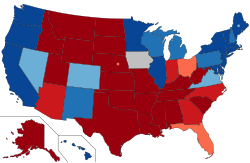
Back نظام حزبي سادس Arabic Sixth Party System Italian 第六政党体系 Chinese Tē-la̍k Tóng-phài Hē-thóng ZH-MIN-NAN
 | ||
| ||
|
| ||
 United States presidential election results between 1964 and 1976 during the Dealignment Period, and results during the main Sixth Party System between 1980 and 2024. Blue shaded states usually voted for the Democratic Party, while red shaded states usually voted for the Republican Party. | ||

The Sixth Party System is the era in United States politics following the Fifth Party System. As with any periodization, opinions differ on when the Sixth Party System may have begun, with suggested dates ranging from the late 1960s to the Republican Revolution of 1994. Nonetheless, there is agreement among scholars that the Sixth Party System features strong division between the Democratic and Republican parties, which are rooted in socioeconomic, class, cultural, religious, educational and racial issues, and debates over the proper role of government.[1]
This party system likely began as a result of a long-term realignment of conservative Southern Democrats, particularly those in the Dixiecratic movement, into the Republican Party because of their disillusionment by the previous realignment of Progressives into the Democratic Party, though the exact timing of the realignment is usually called into question. A "dealignment" period may have begun in 1964, when Goldwater became the first Republican after Reconstruction to win the Deep South (although he lost the overall South),[b] after which the previously heavily-Democratic South at-large and Deep South alternated between parties. The Southern realignment wouldn't finalize until 1984 when Reagan kept all of the South permanently Republican. This Dixiecratic realignment – known as the Southern strategy – would allow Republicans to dominate the White House from 1968 to 1992, though dominant control of Congress would remain in Democratic hands because of the Southern seats in Congress remaining a solid Democratic bloc until the Republicans flipped the Congressional South in the 1994 Republican Revolution. This phenomenon of realignment lag caused heavy ticket-splitting (i.e. the "Nixon Democrats" and "Reagan Democrats").
In addition to this Southern realignment, a second realignment occurred among centrist "independents" in the North and West who supported Anderson and Perot in 1980, 1992 and 1996. Following the 1996 election, these centrists became part of the Democratic Party and by 2008, Democrats had new-found dominance in the North and West. This realignment caused heavy polarization.
Cite error: There are <ref group=lower-alpha> tags or {{efn}} templates on this page, but the references will not show without a {{reflist|group=lower-alpha}} template or {{notelist}} template (see the help page).



